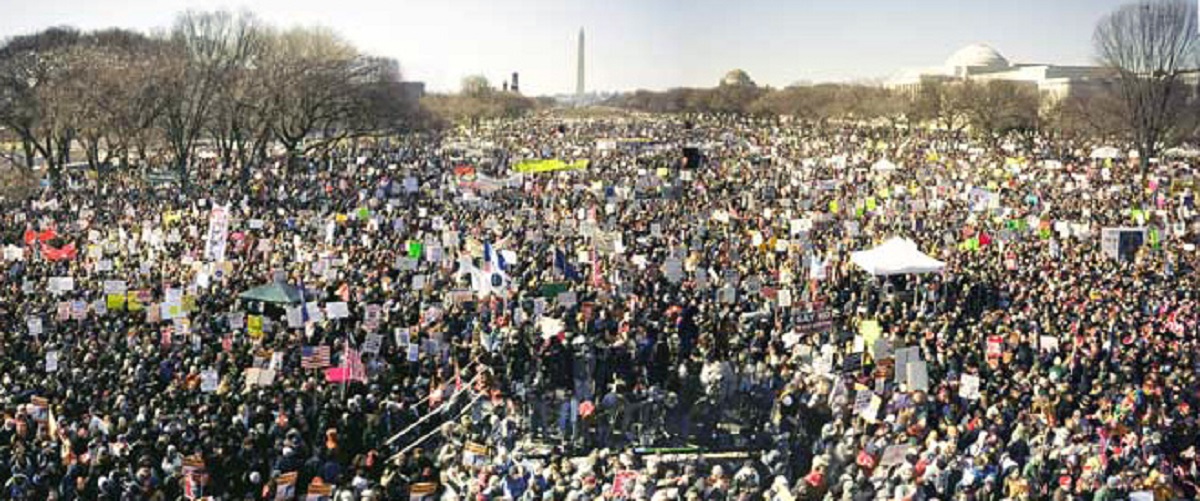
Seventeen years ago today, the U.S. launched an invasion and occupation of Iraq. The results were devastating. Millions of Iraqis and thousands of Americans died. Years later, the country is still in ruins. But this year Iraqis of all walks of life are rising up. In one demonstration alone, millions took to the streets to demand that the U.S. get out. This anniversary provides an opportunity to look back and review the lessons of the war to best combat current U.S. interventions around the globe.
Media acts as Pentagon mouthpiece
The run-up to the 2003 Iraq War is a textbook example of how the corporate media and capitalist state work hand in hand to manufacture consent for the Empire’s wars. Without a shred of evidence, the news media obediently repeated allegations of the George W. Bush administration that the Ba’ath government of Saddam Hussein possessed weapons of mass destruction. The truth is that, in compliance with many UN inspections, Iraq had destroyed its chemical weapons stockpile and halted its biological and nuclear weapons programs a decade before the U.S. attack.
Every news pundit regurgitated the same canned phrases — that Saddam Hussein was a danger to his own people and a danger to the world. Then-Secretary of State Colin Powell even brought a vial of fake anthrax powder to his speech at the UN to scare viewers. This drumbeat of theatrics and lies was used to get a consensus for the U.S. invasion.
While Iraqis did have many grievances with Saddam Hussein’s rule, it is never the place of the U.S. to intervene in other countries and violate their sovereignty. In fact, prior U.S. support for Saddam Hussein, and the devastating results of the war, prove that Washington’s claim of “wanting to help free Iraqis” was simply an excuse to invade.
Democratic Party leadership complicity
The Democratic Party leaders in Congress acquiesced to the war. Even though the calls and letters to Congress against the war were running 200 to 1, both the Senate and the House of Representatives, by lopsided margins, passed resolutions on Oct. 11, 2002, authorizing Bush to use force against Iraq.
In March 2003, the U.S. launched “Shock and Awe,” with 400,000 troops, dropping thousands of bombs on Iraq. While the U.S. claimed it hit only government targets, thousands of Iraqi civilians were killed in this initial phase of the war. U.S. ground troops captured Baghdad by April 9. That the U.S. was able to so quickly capture Iraq’s capital was due in great part to the Iraqi state and military having been hollowed out by the previous U.S. war and sanctions.
First war and sanctions paved the way
After the collapse of the Soviet Union, which had acted as a deterrent to U.S. expansion, Washington sought to regain direct control of the oil-rich Middle East. It began by waging war on Iraq in 1991, bombing and destroying its infrastructure. Until 1991 Iraq had one of the highest standards of living in the Arab world, including free education and free quality health care. But the destruction of infrastructure and a near total 12-year embargo on trade, including essential medicines, caused tremendous suffering and needless death.
A few weeks after the taking of Baghdad in 2003, President George W. Bush gave his infamous “Mission Accomplished” speech, claiming that major combat operations were over. Unbeknownst to him, the actual Iraqi insurgency had yet to begin and combat would rage on for years.
Looting Iraq’s wealth
U.S. official Paul Bremer, installed as head of the Coalition Provisional Authority then ruling Iraq, tore up the Iraqi Constitution. He moved to completely privatize Iraq’s economy, destroying its elements of central planning, nationalization of resources, and social programs.
Laws were passed allowing foreign investment and ownership of Iraqi assets, with full rights to repatriate profits. Some 200 state-owned banks, factories, and utility companies were sold off to foreign investors. Even agricultural products were privatized, allowing for companies like Monsanto to control Iraq’s agricultural market with their patented seeds.
Tariffs and other regulations for foreign contractors were removed. Foreign contractors were given complete immunity from Iraqi law, allowing for companies such as Blackwater to act with impunity.
Huge reconstruction contracts were awarded to foreign companies like Halliburton, using money borrowed against future Iraqi oil revenues. These contractors pocketed billions of dollars and did very little reconstruction. Iraqis are still struggling with crumbling infrastructure and a shortage of electricity, clean drinking water, sewage, and sanitation.
Making Iraq ‘a capitalist dream’
Iraqi oil was the grand prize of privatization, and U.S. troops secured the oil fields as soon as they entered the country. The U.S. pushed hard to privatize Iraq’s oil fields. They even attempted to rebuild an old oil pipeline that ran from Kirkuk to Haifa, in occupied Palestine. These attempts were thwarted by fierce resistance from the Iraqi people, including sabotaging the oil pipelines. The U.S. settled for semi-privatization of the oil fields through service contracts with the Iraqi government. Companies also signed more exploitative oil production-sharing agreements with the regional government of Kurdistan.
The U.S. vision for Iraq can best be summed up in 2003 in The Economist, which stated, “If it all works out, Iraq will be a capitalist’s dream.” This capitalist dream turned out to be a nightmare of poverty and exploitation for Iraqis.
Sectarianism and the destruction of society
To grease the wheels for privatization, Bremer undertook a policy of “De-Ba’athification.” Members of the Ba’ath Party were dismissed from their posts, including almost the entire Iraqi professional class, as membership in the party was a virtual requirement for employment and advancement.
Hundreds of thousands of Iraqi workers including soldiers, teachers, doctors, and civil servants were suddenly jobless. Unemployment reached 40 percent. With the most qualified people to run the country removed, the new dysfunctional Iraqi state was left in the hands of corrupt, inexperienced compradors. The desperate and angry population was soon to rebel.
The tenacity and scale of the Iraq insurgency took the U.S. by surprise. Insurgent militias took over large portions of the country, both in predominantly Sunni areas near Fallujah and Tikrit and in predominantly Shia areas such as Najaf, Nasiriyah, Amarah, and Basra. Dozens upon dozens of attacks took place daily against U.S. troops. The U.S. feared a unified Iraqi insurgency and thus sought to quell the uprisings by exploiting sectarian differences in a “divide and rule” strategy.
The U.S. exploited long-held Kurdish grievances against the former Iraqi state and encouraged Kurdish separatism by making federalization much easier under the new Iraqi constitution. They then turned their attention to the Sunni and Shia Arab population, stoking sectarian tensions between them. Prior to the invasion, sectarian tensions were present but were minimal. Many Iraqis came from mixed, inter-married Sunni-Shia families.
Under the Ba’ath Party, the Iraqi government and its institutions were secular. Bremer and the CPA cemented sectarian and ethnic divisions by installing a governmental system similar to the one installed by French colonialists in Lebanon, where the government is rigidly divided along religious and ethnic lines. This system led to a bloody civil war in Lebanon and similarly led each sect in Iraq to compete against the others for power.
The U.S. began training sectarian Shia militias, which were incorporated into the Iraqi Interior Ministry and police. There, they were trained by former U.S. Colonel James Steele, who had trained right-wing death squads in El Salvador and Nicaragua in the 1980s. The result was torture, kidnappings and reprisals on the Sunni population.
At the same time, the Sunni insurgency was quickly overtaken by foreign, right-wing Islamist factions like Al Qaeda, which had the political and financial backing of U.S. clients such as Saudia Arabia, the UAE, Turkey, and Jordan.
Sectarian tensions exploded in 2006 as insurgents from Al Qaeda bombed Shia religious sites and civilian targets. This drew a response from Shia militias. The result was a bloody tit-for-tat civil war that took the lives of hundreds of thousands of Iraqis and destroyed the concept of a unified Iraqi society.
Entire neighborhoods were ethnically cleansed as members of the opposite sect were forced out of their homes or killed. Car bombs and kidnappings became a part of daily life in Iraq as the country descended into chaos, a far cry from the stable democracy promised by the U.S. These deaths are often conveniently left out when discussing the death toll of the Iraq War.
U.S. war crimes
The U.S. has committed numerous war crimes during the occupation. At Abu Ghraib, just one of many U.S.-run prisons in Iraq where abuses have been documented, U.S. military and CIA personnel tortured, raped, abused and murdered Iraqi prisoners.
The U.S. bombarded the city of Fallujah in 2004 with depleted uranium munitions and white phosphorus, resulting in a dramatic rise of birth defects, childhood cancer, and infant mortality. Iraqis are still dealing with the fallout from these chemical weapons today.
Finally, the disintegration of Iraqi society, sectarian tensions, and the flow of money and weapons to insurgents in Iraq and Syria, led to the rise of ISIS. The group took over large swaths of land and committed unspeakable acts of terror on the Iraqi and Syrian people. The U.S. then used this crisis to prolong its occupation in Iraq and extend it to Syria as well.
It was only with the committed efforts and sacrifices of the Iraqi and Syrian people that ISIS was finally defeated after years of fighting. Yet U.S. troops continue occupying both countries under the pretext of fighting ISIS.
Lessons from Iraq War
Today, the Iraq War is often brought up in the context of it being a “mistake.” It wasn’t a mistake but rather a premeditated crime on the part of the U.S. ruling class to destroy Iraq as a sovereign state and plunder its wealth. Washington relies on organized violence, or the threat of violence, to maintain its dominant world position. The U.S. has invaded or bombed one country after another since the end of the so-called Cold War.
Sanctions; outrageous media lies, including racist vilification of the leaders of oppressed nations; and the complicity of the Democratic Party establishment were also preludes for the bombing and destruction of Libya as a sovereign state, and for the imperialist war that has caused so much suffering in Syria. U.S. economic sanctions against Iran, Syria, Venezuela, Cuba and the DPRK, and Washington’s economic war on China, are meant to destroy those sovereign nations. It is up to anti-imperialists in the U.S. to combat this propaganda, draw parallels to the outright lies fed the population here about Iraq, and expose the disastrous results of U.S. intervention.
The invasion of Iraq succeeded in creating mass human suffering and death, but it could not stop the struggle. What the Pentagon did not anticipate was that the people of Iraq, like people everywhere, would never willingly accept life under occupation. Today, Iraqis from every ethnic and religious group and every region are taking to the streets to demand that all U.S. troops leave their country.





